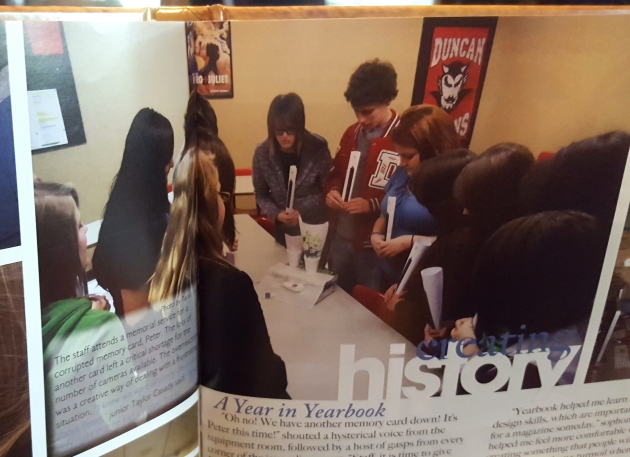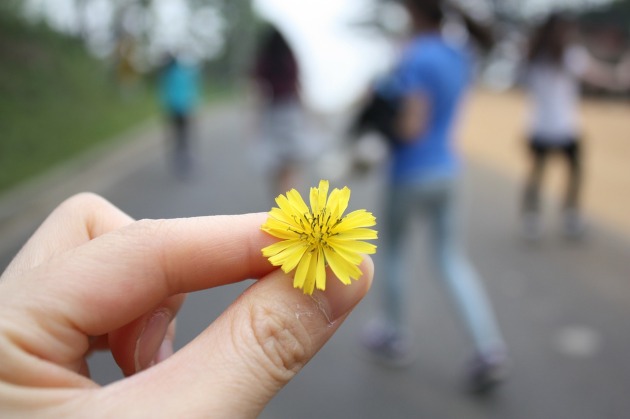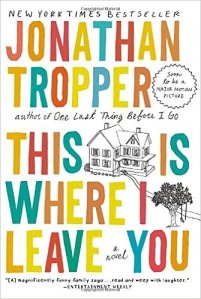So many blog posts started taking shape in my mind the past couple months. Lack of time – or mental capacity when I had time – kept me from bringing any to completion. But I still want to share some successes we had this semester in Digital Communications class. Therefore, I’ll share the high points in a few brief summaries as a sort of wrap-up for this sixth semester of a class I kind of made up and got approved. It’s a combination of communication skills and digital skills with a sampling of situations and apps where they intersect.
Apping Manifestos
I explained what a manifesto is and provided examples such as The Declaration of Independence, Martin Luther King’s I Have a Dream Speech or Apple’s advertisement, Here’s to the Crazy Ones. We looked at the Holstee Manifesto and the different forms it’s presented in: a poster, a video with animated words and a video with happy people on bicycles. Then I challenged them to write their own manifestos. They could use Pinterest to see some other examples and play around with point of view, parallelism and other such things.
After coming up with their words and sharing through Google Docs for feedback from classmates and myself, they used a presentation app, HaikuDeck being the popular choice, and created a slide presentation for their manifesto. They needed to select photos, from creative commons to go with their words and decide how many lines to go on each slide for the right effect. One young lady used PhotoPeach instead and was able to put music to her presentation.
The fun part (not really, they hate presenting) was presenting to the class. I just asked them to present the slides and tell us a little about why they made the choices they did. This seemed an easy way to introduce presentation skills to a fairly small class so they could do something more complex later.
I was quite impressed with what they came up with and the fact that several seemed to enjoy the project. Now they have another presentation resource in their bag of tricks, a little more practice writing for and presenting to an audience.
Creating with Canva
During a week with lots of interruptions for testing, I chose an easy app to learn that has lots of possibilities for use. It was almost as much fun as coloring. Canva is very user-friendly and allows you to create graphic designs to use as profile or cover images for social media accounts, book or magazine covers, invitations, advertisements, images to use for blogs or Pinterest posts, menus, just all sorts of things you’d need to design an image for. The app has just about any dimensions for any task you can think of. I showed off the new Twitter header image I’d made the night before.
I asked that they play around with it, consider creating a presentation cover slide for their Passion Project or something else specifically for their project or just anything they wanted, but they had to write a blog post telling about it. Easy-breezy and relaxing and low-stress. Perfect for testing season.
Passion Project Presentations
The big finale for the semester is the presentations for the Passion Projects. Each student chose, about five weeks into the semester, a topic he or she was interested in and developed a project. Twenty percent of the week for the remainder of the semester was to be dedicated to researching, learning, creating for the project. It was tough getting them to figure out what they were passionate about and then getting them to think of a project that they’d like to do. No one asks them to do what they’d like to do at school, so it required quite a mind shift. Some good ideas came out of it all, some of which worked and some had to be changed up somewhat. But even that provides experiential learning, which is one of the goals.
Most of the projects were about what I’d expected, since I’d been kind of keeping tabs on each student and their progress, but a couple of them really blew me away. I hadn’t realized how much they’d been working on them outside of class.
Truly, I was proud of all of them, even a couple who didn’t really get presentations ready. For those, I had them go ahead and tell what they could about their projects and then field questions from me. Then the class, who’d already seen the other presentations and had caught on to the pattern of questioning and learning more, began asking questions, too. We were able to demonstrate to those two that even though they hadn’t gotten presentation slides done, they really had done research or work on the topic and had learned something. No one did nothing.
Three explored food, but each in different ways. One researched and experimented with gluten-free baking for health reasons. One explored the artistic side of food preparation and presentations and took photos. Another focused on baking desserts that involved candies. She concluded that baked desserts with additional candy were too sweet.
One student made an interactive book for children; one practiced a particular type of cartooning. One artist was invited to paint a wall mural but upped the ante by learning how to video and edit that video to upload to YouTube. It turned out to be quite impressive. Another learned how to use a DSLR camera and took photos of what he considered to be forgotten places on the outskirts of our city. His mentor was one of our yearbook students. A former classmate of mine who is a published poet was mentor to one of these students who worked on his poetry. His original idea of mixing lines from older poems to form something new turned out to be harder than he’d anticipated, though the idea itself was interesting. However, he did get good advice and feedback and wrote and shared an original poem of his own.
Three students did different versions of creating fantasy teams, one football and two soccer. For these projects, they researched real athletes, either college or professional, and chose from them to create a team, decided on a team name, colors, mascot and more.
One of the surprises was a quiet student who always has nice fingernails. She’d told us she was going to try some different nail techniques, but in her presentation, I first thought she was showing us examples of what she wanted to try. No. These were her own nails. She’d done them so many different ways, and they looked every bit as professional as those you see scrolling through Pinterest. When she detected our interest, she told us more of what she had learned about keeping nails healthy, the pros and cons of what nail salons do.
Another student who had really had a hard time deciding on something to do, but knew he liked sports and he liked games, created a new sports game. He wanted something competitive but that could be played at any age. He combined a couple other familiar sports to create a new one and tweaked the instructions a bit. Though it seemed simple on first description, once again, as we began to ask questions and show some interest, he got more interested in sharing with us. He told us that reading up on rules and figuring out what would work and what wouldn’t for his idea was a bit more complex than he’d figured it would be.
All in all, this was a very successful round of Passion Projects. They all wrote blog posts about the experience. I’ve tried to link a few throughout here. One, who found a mentor to teach her to crochet, told her audience how much she got from being allowed to choose her own project, set up her own goals and then present about it. She said everyone should get to do Passion Projects.
Reflection and Self-Assessment via Google Form
I have shared before that I am not using points or percentages this year. With my principal’s blessing, I am providing feedback instead of grades, hoping students will worry less about “how much is this worth?” and more about learning and gaining skills. There have been ups and downs, but all in all, I’d say it was more positive than not.
The real world still requires grades, however, so for each class (I have five preps) I prepared a Google form that asks specific questions about the work done in that class, how much of it they did, how often they accepted feedback, improved the work and resubmitted, what they got out of lessons, and more. One of the recurring themes in the Digital Communications class was that several got more comfortable with presenting in front of people. They realized they could do it, that they could get out of their comfort zone and be OK. One even specified about learning to look audience members in the eye and not lean on anything.
One of the best things I’ve done all year long, and I wish I’d done it sooner, was having them reflect and assess on a Google form. I’d asked them to write something before, giving them guidelines, but they mostly felt lost and didn’t know what I wanted. The result was a huge variety of responses, very few of which really addressed what I was after at the depth I wanted. They told me they liked the Google form, so it’s here to stay.
In the coming week, we’ll be finishing everything, establishing final grades and celebrating seniors with graduation ceremonies. It will be hard to focus on getting done what really needs to be done, because my mind, for weeks now, has already been looking forward to next year, to things I can do better.



